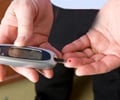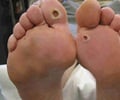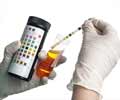
The linchpin is a biosensor engineered by Fraunhofer researchers, which is a tiny chip combines measurement and digital analysis - and can be radioed to a mobile device.
The underlying concept is a biosensor that is located on the patient's body.
It is also able to measure glucose levels continuously using tissue fluids other than blood, such as in sweat or tears.
The patient could dispense with the constant needle pricks. In the past, such bioelectric sensors were too big, too imprecise and consumed too much power.
Researchers at the Fraunhofer Institute for Microelectronic Circuits and Systems IMS in Duisburg have recently achieved a major breakthrough by developing a biosensor in nano-form that circumvents these hurdles.
Advertisement
This measurement is used for calculating the glucose level. The special feature of this biosensor: the chip, measuring just 0.5 x 2.0 millimeters, can fit more than just the nanopotentiostat itself. Indeed, Fraunhofer researchers have attached the entire diagnostic system to it.
Advertisement
The biosensor transmits the data via a wireless interface, for example to a mobile receiver. Thus, the patient can keep a steady eye on his or her glucose level.
"In the past, you used to need a circuit board the size of a half-sheet of paper," Zimmermann said.
"And you also had to have a driver. But even these things are no longer necessary with our new sensor," he said.
The minimal size is not the only thing that provides a substantial advantage over previous biosensors of this type. In addition, the sensor consumes substantially less power.
While earlier systems required about 500 microamperes at five volts now it is less than 100 microamperes. That increases the durability of the system - allowing the patient to wear the sensor for weeks, or even months.
The use of a passive system makes this durability possible. The sensor is able to send and receive data packages, but it can also be supplied with power through radio frequency.
Source-ANI














